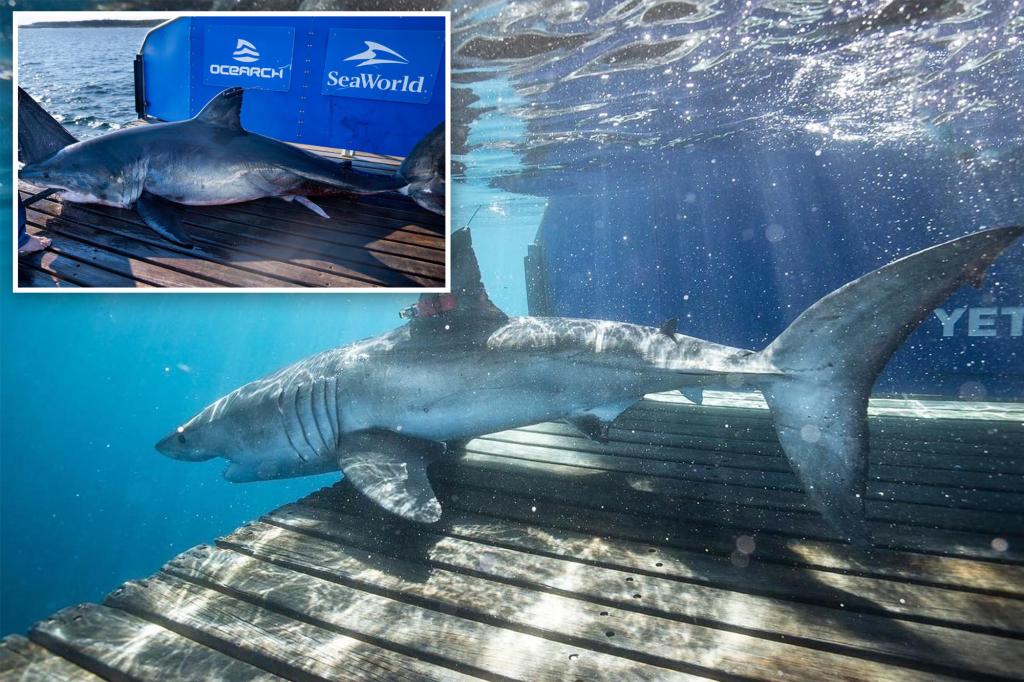Two great white sharks named Scot and Penny are heading back north from the Gulf of Mexico to migrate for the summer. Scot is a massive 12-foot, 1600-pound shark, while Penny is a smaller 10-foot, 522-pound shark. They were pinged near St. Augustine, Florida, by Ocearch, a shark research nonprofit based in Jacksonville, Florida. The organization has attached tags to their dorsal fins that send pings with their locations when they hit the water’s surface. Earlier this year, the pair traveled around Florida, with Scot being tracked off Palm Bay and around the Florida Keys, and Penny being tracked off Fort Myers Beach, Marco Island, Sarasota’s coast, and near Cape Coral.
Great white sharks typically migrate south when water temperatures get colder and their food sources diminish, then head back to the Northeast with the warmer weather. Ocearch provides an online map for people to track the travels of their tagged sharks. The organization currently has tags on 371 sharks, including 123 great white sharks. Four of the tagged sharks were spotted in the waters surrounding New York and New Jersey in May. Last summer, there were at least five shark bites in Long Island waters, leading to the deployment of shark-spotting drones across the beaches in the region, including New York City.
The return of great white sharks to the Northeast marks the beginning of the summer season. Scot and Penny, along with other snowbirds, are making their way back up north after spending the winter in the Gulf of Mexico. Ocearch’s tracking system allows researchers and the public to monitor the movements of these sharks and learn more about their behavior and migration patterns. Understanding the movements of these apex predators is crucial for conservation efforts and ensuring the safety of both marine life and humans in coastal areas.
Scot and Penny, the two great white sharks recently pinged near St. Augustine, Florida, are part of the larger population of sharks that migrate seasonally along the East Coast. Ocearch’s tagging program provides valuable data on the movements of these sharks, helping scientists to track their migration routes, feeding habits, and interactions with other marine species. By studying the behavior of great white sharks, researchers can gain insights into the health of ocean ecosystems and the potential impacts of climate change on these iconic predators.
As the summer progresses, more sharks are expected to return to the Northeast, following Scot and Penny’s lead. The data collected by Ocearch and other research organizations will continue to provide valuable information on the movements of these sharks and their importance in marine ecosystems. By raising awareness about shark conservation and promoting coexistence between humans and sharks, researchers hope to ensure the long-term survival of these apex predators and the health of our oceans. Observing the return of great white sharks to the Northeast is a reminder of the interconnectedness of marine life and the need for conservation efforts to protect these majestic creatures.
In addition to the seasonal migration of great white sharks, Ocearch’s tracking program also reveals the diverse movements of other marine species along the East Coast. By monitoring the locations of tagged sharks and other marine animals, researchers can identify critical habitats, migration corridors, and potential conservation threats. The data collected by Ocearch and other research organizations contribute to a better understanding of marine biodiversity and the need for effective conservation measures to protect our oceans. Through collaborative research and public engagement, we can work together to safeguard the future of our marine ecosystems and the diverse species that call them home.


